Hello, dear students, and welcome to an interesting lesson on Unity in Diversity in India!
Our dedicated team of expert teachers, educated both in India and overseas, has carefully crafted this solution to help you explore one of India’s most unique strengths. Each idea is shared in a simple and engaging way to make understanding this concept easy and enjoyable.
In this lesson, you’ll discover how people from different cultures, languages, religions, and traditions come together to form one incredible country. You’ll learn about the unity that brings us closer and how diversity makes our nation vibrant and colourful.
Find Solutions for NCERT Class 6 Social Science Exploring Society: India and Beyond Chapter 8 Unity in Diversity, or “Many in the One,” here.
Text book Page 126
The Big Questions?
1. What is meant by ‘unity in diversity’ in the Indian scenario?
Answer:
In the Indian scenario, ‘unity in diversity’ means that in spite of the infinite variety in terms of culture, language, religion, ethnicity and traditions, there exists a strong sense of oneness and affinity among its inhabitants. This concept reflects how diverse elements have the unique ability to coexist harmoniously, while still maintaining a sense of national unity and shared identity.
2. What aspects of India’s diversity are the most striking?
Answer:
Some of the most striking aspects of India’s rich diversity include:
Languages: India is home to 325 languages with 25 scripts, and hundreds of dialects as per survey by Anthropological Survey of India. There are 22 official languages and most states have their own language, such as Tamil in Tamil Nadu, Bengali in West Bengal, and Marathi in Maharashtra, Gujrati in Gujrat, Assamese in Assam, Kannada in Karnataka, Malayalam in Kerala and so on.
Religions: Major religions like Hinduism, Islam, Christianity, Sikhism, Buddhism, and Jainism coexist in the country along with many other religious beliefs prevalent among the different tribes. People in India celebrate different religious festivals and have respect for each other’s beliefs. Major festivals like Diwali, Christmas, Navratri, Pongal, Buddha Purnima and Baisakhi are celebrated with great fervour, each showcasing unique cultural practices.
Ethnicity: Various ethnic groups, including Indo-Aryans, Dravidians, Mongoloids, and others co-exist peacefully. Each group has distinct traditions, clothing, and customs.
Food: Indian food is different in each region. In the North, people eat more wheat-based foods like chapati, while in the South, rice and coconut are common in meals, Rice and fish are popular in Bengal, Assam and Odisha. Many Indians are vegetarian, while others prefer non-vegetarian food.
Geography: India has various types of land forms – from the tall Himalayan mountains in the North to the beaches in the South. The Thar Desert, the Deccan plateau, the green northern plains add to the diversity of landscapes.
Art and Architecture: India is known for the variety of classical dance forms, music, and beautiful architecture. From ancient temples, forts and palaces to modern buildings, each place has its own unique style.
Textiles and Clothing: India is home to many different kinds of handloom materials produced by different weaving techniques across the country. India produced some of the finest cotton weaves which were sought after by Europeans. Besides there are a multitude of silk weaves like Banarasi, Kanjivaram, Paithani, Patan Patola, Muga or Mysore silk.
People in different parts of India wear different types of clothes. In some areas, women wear sarees, while in other places, they may wear salwar kameez or lehengas. It may be mentioned that although the saree and dhoti are popular garments in many states, the way it is draped varies from one region to another.
Traditions: Each community has its own customs, like different types of wedding ceremonies and festivals. For example, Durga Puja is celebrated in Bengal, while Onam is important in Kerala, Rath Yatra in Odisha.
Literature: Indian literature is extremely diverse (and among the most abundant in the world). Over centuries, despite differences in language, technique, etc., they have shared important themes and concerns. For example, the ‘Panchatantra’ was originally in Sanskrit, but the stories have been translated into almost every Indian language. Similarly, the Ramayana and the Mahabharata have been adapted to almost every Indian language. In fact, there are about a hundred versions of the ‘Mahabharata’ that have come down in folklore form.
3. How do we make out the unity underlying the diversity?
Answer:
Underlying the diversity in this country of contrasts is a strong bond which holds Indians together. Unity in India can be seen in the way people come together despite their apparent differences. The country has a shared history, especially the fight for freedom from British rule, which united everyone.
All Indians also adhere to the same set of rules and values, like equality and justice, which are enshrined in the Constitution.
National symbols like the Indian flag and the national anthem bring people together as they symbolise national pride. On Independence Day and Republic Day, people from all over the country celebrate together, in a display of their devotion to the country.
Two important concepts that help unite India are Swabhava (everyone’s natural way of living) and Swadharma (everyone’s duty). These concepts remind people to respect each other’s differences, like language, religion, or traditions, and to live peacefully together.
India‘s democratic system of government, where everyone has the right to vote and choose leaders, also plays a big role in bringing unity. Even though people are different in many ways, they work together for the good of the country.
LET’S EXPLORE
Text Book Page 126
As a class activity, make lists of (1) the birthplaces of at least 5 classmates and the birthplaces of their parents; (2) the students ‘mother tongues and other languages known to them. Discuss the results in terms of diversity.
Answer:
Steps to prepare the Chart
Collect Information: Ask 5 students to provide their birthplace, their parents’ birthplaces, and the languages they know, including their mother tongue.
Fill in the Chart: Fill out the chart with all the gathered information.
Answer:
A sample chart is provided for your reference:
| Student’s Name | Student’s Birthplace | Father’s Birthplace | Mother’s Birthplace | Languages Spoken by Student | Languages Spoken by Parents |
| Aryan Singh | Delhi, | Patna, Bihar | Lucknow, Uttar Pradesh | Hindi, English | Hindi, English |
| Meera Nair | Kochi, Kerala | Trivandrum, Kerala | Chennai, Tamil Nadu | Malayalam, Tamil, English | Malayalam, Tamil, English |
| Rohit Dave | Mumbai, Maharashtra | Pune, Maharashtra | Jaipur Rajasthan | Marathi, Hindi, English | Marathi, Hindi |
| Ayesha Ahmed | Hyderabad, Telangana | Bengaluru, Karnataka | Hyderabad, Telangana | Urdu, Telegu, English | Urdu, Telegu, Kannada, English |
| Rinchen Dorjee | Leh, Ladakh | Leh, Ladakh | Kurseong, West Bengal | Ladakhi, Nepali, Hindi, English | Ladakhi, Nepali, Bengali, Hindi, English |
This chart highlights the diversity in birthplaces and languages spoken by students and their families, showcasing India’s rich cultural diversity. It reflects the diversity in the country. We can see that most people are bilingual, many speak three languages or even four. This chart reflects the linguistic diversity of our great country.
Text Book Page no 128
LET’S EXPLORE
(i) As a class activity, make a list of ingredients (grains, spices, etc.) that are used in your home.
Answer:
Here’s an exhaustive list of ingredients commonly used in our home, i.e. Bengali household:
Grains and Pulses
Rice (Chal) – The staple grain
Atta (Wheat Flour) – For making rotis or puris
Moong Dal – Yellow split lentils
Masoor Dal – Red lentils
Cholar Dal – Bengal gram lentils
Urad Dal – Black gram lentils
Spices
Turmeric (Haldi)
Cumin Seeds (Jeera)
Coriander Powder (Dhania)
Mustard Seeds (Sorshe)
Fenugreek (Methi)
Randhuni (wild celery seeds)
Kalonji (Nigella Seeds)
Bay Leaves (Tej Patta)
Cinnamon (Dalchini)
Cardamom (Elaichi)
Cloves (Laung)
Red Chili (whole)
Red Chili Powder
Green Chilies
Oil
Mustard Oil – Essential for cooking
Vegetables
Eggplant (Baingan/Begun)
Potatoes (Aloo)
Pumpkin (Kumro)
Bottle Gourd (Lau)
Bitter Gourd (Ucche)
Pointed Gourd (Parwal/Potol)
Cauliflower (Phulkopi)
Cabbage (Bandakopi)
Tomatoes (Tamatar)
Fish and Proteins
Rohu (Rui) Fish
Hilsa (Ilish) Fish
Prawns (Chingri)
Eggs
Chicken – Optional in some households
Dairy Products
Milk (Dudh)
Ghee – Clarified butter
Paneer – Fresh cheese
Condiments
Tamarind (Imli)
Kasundi – Bengali mustard sauce
Salt
Sugar – Often used in cooking
This list represents many staples in a typical Bengali kitchen, reflecting the region’s diverse and flavourful cuisine.
(ii) Take any one vegetable and think of the number of different dishes you can prepare with it.
Answer:
Different Dishes with Baingan (Eggplant)
Here are different dishes that can be prepared with baingan:
1. Baingan Bharta
(Roasted eggplant mashed and cooked with spices)
2. Baingan Fry
(Sliced eggplant coated with spices and fried)
3. Baingan Aloo Sabzi
(Eggplant and potatoes stir-fried with spices)
4. Stuffed Baingan
(Eggplants stuffed with a spicy mixture of ground spices and onions)
5. Baingan Pakora
(Eggplant slices dipped in chickpea flour batter and deep-fried)
6. Baingan Curry
(Eggplant cooked in a gravy made of onions, tomatoes, and spices)
7. Baingan Raita
(Roasted or boiled eggplant mixed with yogurt and spices)
This activity is designed to help students explore the versatility of a single vegetable like baingan(eggplant) and see how it can be used to create a variety of delicious dishes.
Text Book page no 129
LET’S EXPLORE
Explain how the example of the sari reflects both unity and diversity (in 100-150 words).
Answer:
The sari, a symbol of Indian culture and tradition, is a perfect example of unity in diversity in India. The sari is a plain length of cloth made from different fabrics, mostly cotton and silk. India has a rich variety of saris from different regions, for example, Banarasi, Kanjivaram, Paithani, Patan Patola, Bandhani, Chikankari. Sambalpuri, Pochampally, Gadwal, Ikkat, Dhakai (cotton), Bomkai, Baluchari, Ghatchola, and Chanderi, each reflecting the culture and history of the region.
It is an unstitched garment, so it is very versatile and can be draped in different ways. The length of the sari is usually around 6 feet, but in Maharastra they are about nine feet long. The added length is suited to their unique style of draping the sari.
Despite being a common garment, the way a sari is draped differs from state to state, exhibiting their regional identities. In Bengal, it is draped in the conventional ‘aatpoure’ style, while in Maharashtra, the ‘Nauvari’ style resembles a dhoti.
The sari, while symbolizing a shared cultural heritage, represents the diversity in fabrics, colours, patterns, and draping techniques unique to different communities. This blend of unity and diversity is a reflection of India’s cultural richness.
Text Book page no 130
LET’S EXPLORE
(i) In the above pictures, can you recognise what a sari has been used for?
Answer:
In the following pictures sari is used for practical purposes:
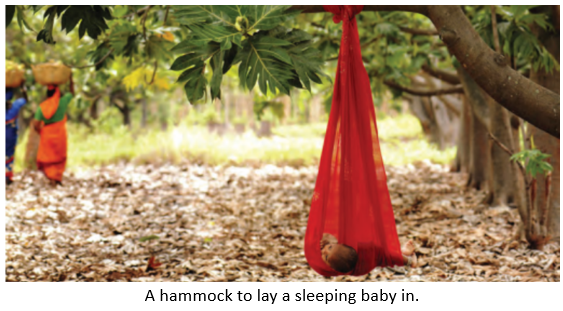
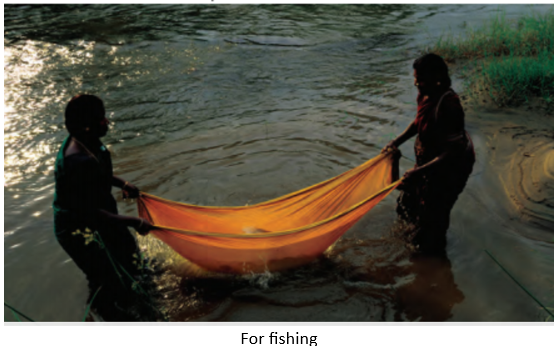
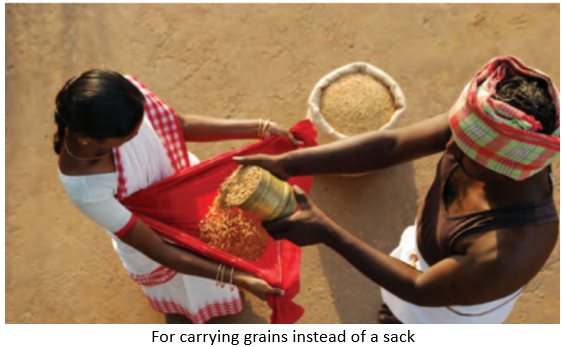
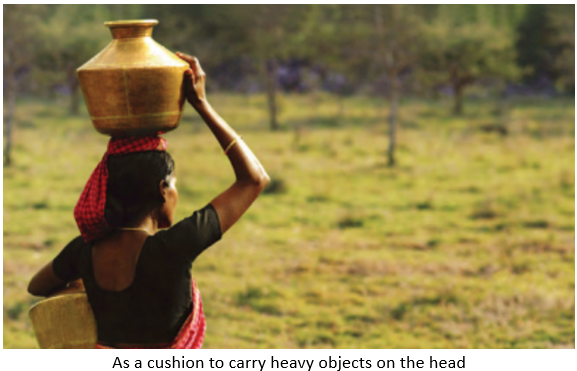
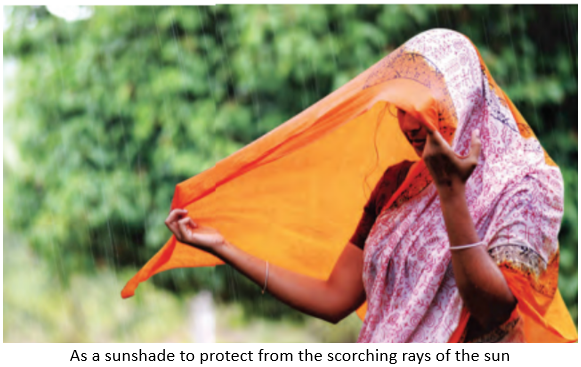
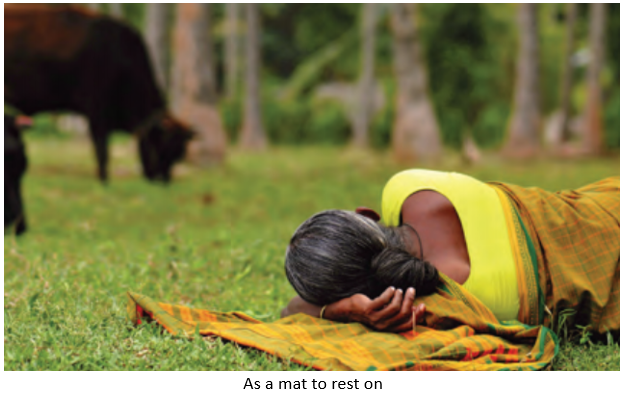
These versatile uses of the sari show its importance not only as a garment but also as a practical tool in everyday life.
(ii) Are you aware of, or can you imagine, more uses for the sari?
Answer:
The sari can be used creatively in many other ways since it is unstitched. Some are mentioned below:
As a sling for carrying objects or even babies
As curtains for doors
As sheets
As table spreads
To make temporary shelters
To partition rooms
(iii) Following the example of the sari, make a list of different styles you have seen for the dhoti — both as regards the fabric and the uses the dhoti can be put to. What conclusion can you draw.
Answer:
Like the sari worn by women, the traditional garment worn by men in India called the ‘Dhoti’ is also an unstitched length of cloth made from different fabric types.
Most of them are Cotton, a lightweight and breathable fabric often worn for everyday use, especially in hot and humid climates. Some are made of silk and used for special occasions like religious ceremonies and weddings. Dhotis made from khadi, a hand spun natural fabric, which has a historical significance due to the importance of khadi during the independence movement, are worn to promote traditional values. Linen dhotis are also popular in warmer regions. Woollen dhotis are worn during winter months.
Like the sari, the dhoti too is worn in different styles by people belonging to different regions.
It is most common in South India where the fabric is pleated in the front and tied at the waist.
In Bengal, the dhoti is tied high on the waist and intricately draped with pleats tucked in front, while the free end of the dhoti is passed between the legs and tucked at the back of the waist.
The Maharashtrians wear the dhoti with part of it coming between the legs and tucked at the back providing ease of movement like trousers. Paired with a long kurta or shirt, the dhoti is a traditional formal garment in many parts of India.
Like the sari, the dhoti too can be used as a sling to carry goods or babies, as a sheet or a wrap, for fishing or straining water, as curtains or room dividers, as a mat or a sheet.
The dhoti, much like the sari, is highly versatile and adapts to different cultural, geographical, and climactic conditions. The variety in fabric and styles reflects the adaptability of this traditional garment.
Text Book Page 132
LET’S EXPLORE
(i) What is your favourite festival and how is it celebrated in your region? Do you know whether it is celebrated in any other part of India, maybe under a different name?
Answer:
My Favourite Festival: Holi
Holi, the festival of colours, is one of the most joyous and vibrant festivals celebrated across India. It marks the arrival of spring and the victory of good over evil, symbolizing the burning of the demoness Holika, Hiranyakashipu’s sister, who tried to kill Prahlad, but was burnt to ashes instead. Here’s how it is celebrated in different parts of the country:
Celebration in My Region:
In Delhi, Holi is celebrated with great fanfare. People gather in the morning to play with coloured powders (gulaal), water balloons, and water guns. Everyone participates in light-hearted fun as families and friends visit each other to smear each other with colours and exchange sweets like gujiya and malpua. The preceding night, a bonfire known as Holika Dahan is lit, signifying the burning of evil forces. The air rings with joy, laughter, and the sounds of dhols (drums) as people sing and dance.
Holi is a festival which is celebrated across India with many regional variations:
Mathura and Vrindavan (Uttar Pradesh): Holi here is special as it is believed to be the birthplace of Lord Krishna. The celebrations in Mathura and Vrindavan last for over a week, with devotees gathering to play with colours and flower petals.
The Lathmar Holi in Barsana is unique, where women playfully hit men with sticks. It is said that Krishna visited Barsana to tease Radha and her friends during Holi. In response the women chased him and his friends with sticks or ‘lathis’. This scene is enacted during Holi every year and draws many tourists.
Shantiniketan (West Bengal): In Shantiniketan, Holi is celebrated as ‘Basanta Utsav’ or spring festival, introduced by the poet Rabindranath Tagore. Students dressed in bright yellow attire and adorned with flowers perform cultural dances, songs, and poetry. The celebration is graceful and artistic compared to the wild play of colours seen in other parts of India.
Punjab: Holi in Punjab coincides with the festival of Hola Mohalla, which is celebrated by the Sikh community. Martial arts demonstrations, mock battles, and military parades are carried on alongside the usual playing of colours.
Rajasthan: In Rajasthan, the royal families often host grand Holi celebrations with traditional music and folk dances. The streets of Jaipur and Udaipur teem with locals and tourists alike playing with colours and enjoying the festive spirit.
Goa: In Goa, Holi merges with the spirit of the local carnival called Shigmo, and it includes processions, folk dances, and vibrant street performances, with people playing with colours in the evenings.
Maharashtra: In Maharashtra, Holi is celebrated with special significance. People make puran poli and the bonfire of Holika Dahan is an essential part of the ritual. The next day, the celebration of Rang Panchami is full of colour and water fights, especially in Mumbai and Pune.
Uttarakhand: In Uttarakhand, Holi is celebrated in an intimate way with traditional songs and communal gatherings. It is known as Baithki Holi when the community gathers together to sing folk songs while smearing each other with colours. Holi is is one of the most important festivals of the region beginning with Vasant Panchami and ending on Mahashivaratri.
Gujarat: In Gujarat, Holi marks the end of winter and the harvest season. Huge bonfires are lit and the victory of good over evil is celebrated. The following day is full of colour play, with everyone from children to the elderly joining in the festivities.
Holi truly reflects the diversity of India, as each region adds its own unique rituals to the festival, while the core spirit of celebration and joy are felt all over the country.
(ii) During October–November, many major festivals take place in India. Make a list of the few main ones and their various names in different parts of the country.
Answer:
Major Indian Festivals in October–November and the various names they are known by in different parts of the country are given below:
1. Diwali
Deepavali (South India)
Deepawali (North India)
Kali Puja (West Bengal)
2. Dussehra
Vijayadashami (South India)- worshipping Goddesses in Tamil Nadu Almost all houses arrange popular doll shows
Dasara (North India)- celebrates Rama’s victory over Ravana by burning of effigies of Ravana, Kumbhakarna and Meghnath
Mysore Dussehra – Grand procession with Goddess Chamundeshwari atop a golden howdah
Kullu Dussehra- Week long celebrations -deities brought down from different villages to Kullu valley
Varanasi – Ramlila performance in Ramnagar.
3. Navratri
Durga Puja (West Bengal)– celebrates the victory of Mother Durga over Mahishasura
Navratra (Gujarat) – Garba, a folk dance with multi-coloured sticks is the prime attraction of this festival.
Dasara, Karnataka – A vibrant carnival like festival also known as Mariamma festival.
4. Gurpurab
Guru Nanak Jayanti (North India)
Guru Nanak Gurpurab (Punjab)
5. Bhai Dooj (Bhaiya Dooj)
Bhai Dooj / Bhaiya Dooj (North India)
Bhai Phonta (West Bengal)
Bhau Beej (Maharashtra)
Bhai Beej (Gujarat)
6. Chath Puja
Chhath Puja (Bihar and Jharkhand)
Surya Shasthi (Uttar Pradesh)
These festivals reflect the rich cultural diversity of India, with each region adding its unique touch to the celebrations.
Text book Page no 134
LET’S EXPLORE
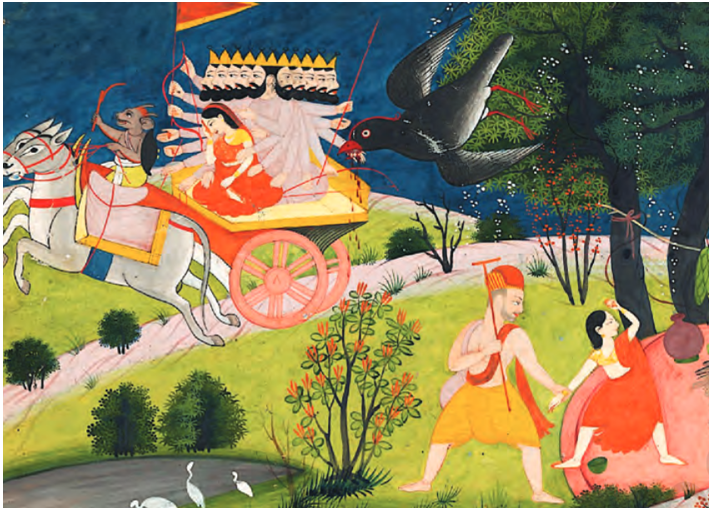
In a class discussion, try to identify the episode depicted in the painting shown in and important
detail associated with it.
Answer:
The episode depicted in the painting is from the Ramayana, specifically the scene of Sita’s abduction by Ravana. The scene portrays the moment when Ravana dupes Sita into stepping out of the protective line drawn by Lakshman (Lakshman Rekha), leaving her exposed, unprotected and at his mercy.
Important Details Associated with This Episode:
Lakshman Rekha: Lakshman drew a magical line around the cottage to protect Sita before he went in search of Rama who was chasing the golden deer in the forest. The line is believed to have protective powers, it could repel evil powers.
Ravana’s Deception: Ravana, dressed as a sage, tricks Sita into stepping out of the Lakshman Rekha by appealing to her devotion and duty to feed wandering sages. She is deceived by Ravana’s guise and falls into his trap.
The Consequences: This episode is pivotal in the epic because it leads to Sita’s abduction and eventually to the war between Rama and Ravana. It symbolizes the ongoing struggle between good (Rama) and evil (Ravana).
The Role of Sita: Sita is driven by her duty to offer hospitality to someone in need, stressing the value of compassion and duty towards others, even when faced with uncertainty.
This episode from the Ramayana is a turning point in the story but also underscores the moral lesson that appearances can be deceptive, and integrity should be maintained even in difficult times.
Questions, activities and projects
1. Conduct a class discussion on the two quotations at the start of the chapter.
“Oh, grant me my prayer, that I may never lose the bliss of the touch of the one in the play of the many.”
– Rabindra Nath Tagore
“The principle of unity in diversity which has always been normal to [India] and its fulfilment the fundamental course of her being and its very nature, the Many in the One, would place her on the sure foundation of her Swabhava and Swadharma.”
– Sri Aurobindo
Answer:
In the first quotation, Tagore prays that he never loses the joy (“bliss”) of feeling God’s presence, even when experiencing the variety of life around him. This shows his faith in the unity of all things through a divine connection, despite the many differences in the world.
In the second quotation, Sri Aurobindo says that India has always been a land where many diverse people have lived together in harmony. Even though there are many religions, languages, and traditions, we are still united as one. This unity in diversity is the strength and true nature of our country.
Both Tagore and Aurobindo talk about staying connected and united, even when there are many differences around us.
Unity in diversity means that even though we might speak different languages, celebrate different festivals, or follow different traditions, we all belong to the same country.
Both quotes remind us that differences make life interesting and colourful, but it is important to stay connected and united as one, whether in a family, a class, or a country like India. This unity is what makes us strong.
2. Read the National Anthem and its translation in the preliminary pages of this textbook. Where do you see the diversity? And where the unity? Write two or three paragraphs on this.
Answer:
The National Anthem of India highlights diversity by mentioning different regions and geographical features. The words like “Punjab, Sindh, Gujarat, Maratha, Dravida, Utkala, Banga” emphasize the cultural and regional diversity of India, as they represent different states and regions with distinct languages, traditions, and lifestyles.
Similarly, words like “Vindhya Himachala, Yamuna, Ganga, Ucchala Jaladhi Taranga” (the Vindhya and Himalaya ranges, the rivers Yamuna, Ganga, and the waves of the seas) also showcase the geographical diversity, mentioning India’s majestic mountain ranges, life-sustaining rivers and coastal areas, which influence the livelihood and culture of people across the country.
In the National Anthem, the words “Bharata Bhagya Vidhata” (“the dispenser of India’s destiny”) show unity. These words signify that no matter where people come from or what languages they speak, everyone in India is bound by the same destiny. The phrase includes the entire nation, suggesting that all citizens, from every corner of India, share a common future and responsibility.
Further, the phrase “jan-gana-mangal” (welfare of the whole people) evokes a collective spirit of patriotism and a shared aspiration for the nation’s progress.
Additionally, the repetition of the word “Jaya he” (“Victory to thee”) reflects the victory and rejoicing of all Indians as one united nation. These words salute the collective success and unity of the people.
So, we can see how beautifully the National Anthem “jana gana mana” represents the spirit of ’unity in diversity’.
3. Select a few stories from the Pañchatantra and discuss how their message is still valid today. Do you know of any similar stories from your region?
Answer:
Some stories from the Panchatantra which carry timeless messages are discussed below:
(i)
The Weaver and the Two Demons
A poor weaver once came across two demons fighting over a magical stick, a pair of shoes, and a bowl in a forest. The clever weaver tricked the demons and ran off with all the magical items.
Then the weaver grew rich as he could make anything he desired using the stick, he could travel anywhere he desired if he wore the magic shoes and the magic bowl ensured that he always had plenty of food.
However, the weaver became greedy and started misusing the magic. Eventually, his greed led to his downfall, and he lost everything as the Gods were angered and took back the magic things.
Message: This story teaches us the danger of greed and the importance of using resources wisely. Even today, the lesson is that being greedy or wanting too much too quickly can lead to problems. It’s a reminder to be satisfied with what we have and to use our skills and resources responsibly.
(ii)
The Mice That Ate Iron
A merchant left an iron beam with his trusted friend before embarking on a long journey. When he returned, his friend lied and told him that mice had eaten up the iron bar. The merchant, understood the trick, and decided to teach his friend a lesson by hiding the friend’s son and stating that a huge bird had flown off with him. The friend, realized his mistake and quickly admitted selling the beam and returned it. Then the merchant returned his son.
Message: The story is a lesson on the importance of honesty and fairness. It also highlights that deceit often backfires, and it’s better to be honest from the start.
(iii)
The Brahmin and the Three Crooks
A Brahmin was tricked by three crooks who convinced him to believe that the goat he was carrying, was something as worthless or impure as a dog or a dead animal. Eventually, the confused Brahmin abandoned the goat, and the crooks stole it.
Message: This story teaches the importance of thinking critically and not blindly trusting others. It emphasizes the need for being cautious when making decisions.
These stories all teach timeless values like kindness, honesty, and critical thinking, which are relevant even now for young learners as they grow and learn to make important decisions in life.
Here’s a story from my region which also teaches a valuable lesson:
The Wise Pigeon
A hunter once caught a pigeon in a net and, feeling cold and tired, decided to rest under a tree. Another pigeon who nested in that tree saw the hunter shiver with cold. Feeling sorry for the cold and hungry hunter, the kind pigeon decided to help. It offered some food and gathered small twigs and leaves to make a fire for the hunter. Moved by the pigeon’s generosity, the hunter freed the captured pigeon and left without harming either bird.
Message: The story teaches the value of compassion and generosity, even toward those who might seem like enemies. By showing kindness, the pigeon succeeded in changing the hunter’s heart. Youngsters must be aware of the power of empathy and generosity as they grow up to be responsible individuals.
4. Collect a few folk tales from your region and discuss their message.
Answer:
Here are a few folk tales from Madhya Pradesh, along with their messages:
(i)
The Story of Raja Nal and His Wisdom
Raja Nal was known for his wisdom and sense of justice. He loved nature and understood the needs of animals which helped him solve problems in creative ways. One day, a group of farmers came to him, complaining about a wild boar which was destroyjng their crops. Instead of ordering his men to capture the animal, Raja Nal intently observed its behaviour and came to the conclusion that the boar was driven by hunger. So, he made arrangements for the boar to be fed elsewhere, saving the crops without harming the animal.
Message: This story teaches the importance of empathy, wisdom, and non-violent solutions to problems. It highlights the value of understanding the root cause of an issue before making a decision, exhibiting that kindness and careful thinking can lead to peaceful solutions.
(ii)
The Banyan Tree and the Ghost
In a remote village, there was a giant banyan tree which was reported to be haunted by a ghost. People feared going near it, but one curious young boy, with a love for adventure, decided to investigate. He befriended the “ghost,” which was actually an old man who lived in the tree to escape from the world. The boy helped the old man return and reclaim his place in the village, and thereafter the villagers no longer feared the banyan tree.
Message: This story teaches the importance of curiosity, kindness, and understanding. It reveals that fear often comes from misunderstanding and that helping others can solve even the scariest of problems. It is important to question our fears instead of simply believing in them.
(iii)
The Old Woman and the Pumpkin
An old woman lived alone in a small village. One day, she decided to visit her daughter who lived in a faraway village. Afraid of traveling alone, she devised a clever plan to protect herself from harm. She carried a giant pumpkin wrapped in a sack on her head, pretending that it was a wild beast to scare off thieves. On the way, a group of robbers accosted her, but on hearing about the huge “beast” on her head, they fled in fear. The old woman safely reached her daughter’s house unharmed.
Message: This story emphasizes the value of using wit and creativity to solve problems. The old woman’s quick thinking helped her stay safe without needing strength or weapons. Intelligence and creative solutions are often more effective than brute force.
5. Is there any ancient story that you have seen being depicted through a form of art? It could be a sculpture, a painting, a dance performance, a movie … Discuss with your classmates.
Answer:
One of the most popular ancient stories is the Ramayana. It has been portrayed in various forms of art, including sculptures, paintings, dance performances, and even movies.
The Ramayana has also been adapted into films and TV shows. One of the most viewed adaptations is the classic Indian television series “Ramayan”, which recreated the ancient story on the small screen. It had a captive audience and helped younger generations understand the moral and ethical values which were portrayed in the ancient epic. The values such as devotion, righteousness, and the victory of good over evil are universal and still hold true.
6. Discuss in class the following quotation by India’s first prime minister, Jawaharlal Nehru, when he travelled to many parts of India before Independence:
“Everywhere I found a cultural background which had exerted a powerful influence on their lives. … The old epics of India, the Ramayana and the Mahabharata and other books, in popular translations and paraphrases, were widely known among the masses, and every incident and story and moral in them was engraved on the popular mind and gave a richness and content to it. Illiterate villagers would know hundreds of verses by heart and their conversation would be full of references to them or to some story with a moral, enshrined in some old classic.”
Answer:
The above quote by Jawaharlal Nehru reveals the rich cultural and literary heritage that moulded the minds of the people of India, even before Independence. When he speaks of a “cultural background” influencing the masses, Nehru stresses how India’s ancient epics—the Ramayana and the Mahabharata—and other classical literary works were deeply ingrained in the daily lives of people, especially in rural areas.
Despite widespread illiteracy, many villagers had memorized hundreds of verses of these epics, exemplifying how oral traditions kept the stories alive. The stories from these epics weren’t just for amusement but also served as a code of conduct, shaping values and outlooks. In conversations, people would refer to characters, events, and lessons from these ancient texts, which shows how these stories shaped social norms as well as the identity of the common Indian people.
These epics, with their universal themes of duty, morality, and righteousness, are still relevant in modern India, influencing not just literature and art but also everyday life. The abiding interest in these ancient stories contribute to India’s cultural unity despite its diversity.
Frequently Asked questions (FAQs) on NCERT Solutions for Class 6 Social Science Exploring Society: India and Beyond Chapter 8 Unity in Diversity, or ‘Many in the One’
Our team of competent subject experts, educated both in India and overseas, has thoughtfully crafted these solutions to ensure they are not only accurate but also engaging and easy to understand. Every concept is explained in a lucid and clear manner, making learning enjoyable and helping you grasp the material with ease.
We encourage you to dive into these solutions, as they’re designed to clarify all your doubts and strengthen your understanding of the lesson. You can download the free PDFs anytime for easy access!
And there’s even more on the way—exciting study material and helpful resources are coming soon! Keep visiting our website and don’t forget to join our email list to stay updated and gain free access to all the new content. Happy learning!
Yes indeed! You can download the free PDF versions of these excellent solutions anytime (please look towards the top of the page)!
Absolutely! Our team of skilled subject teachers has carefully thought through every question you may have about Chapter 8: Unity in Diversity, or Many in the One, and created these solutions to guide you through each important point. These solutions not only cover the key details but also help you fully understand the chapter’s message.
In Chapter 8, Unity in Diversity, you’ll discover how India’s strength comes from its amazing variety of cultures, yet all these cultures come together to make one nation. This unity is more than just an idea; it’s something we see every day in the way people with different languages, religions, and traditions live side by side. By studying this chapter, you’ll see how, even though we are all unique, we all belong to one big family called India.
As you go through the solutions, take time to read each explanation, and try practicing your answers. This practice will not only help you understand better but also make you feel more confident, ready for any question that comes your way. Remember, with practice and a positive spirit, you’ll be well-prepared. We’re cheering for you all the way—keep going, and good luck!
Are you feeling overwhelmed by too many study options or unsure about where to start? You’re not alone! Many students face the same challenges, but the good news is, we’re here to help.
At educationroundtheworld.com, our expert teacher-mentors are dedicated to guiding you every step of the way. We understand how frustrating it can be to feel stuck or stressed. That’s why we offer personalized coaching tailored just for you. With our support, you can say goodbye to confusion and unnecessary pressure.
Here’s how it works: Simply reach out to us or book your first session now. From there, we’ll create a clear, stress-free plan that’s focused on your success. Imagine a study experience where you feel confident, empowered, and ready to reach your full potential!
The path to success is just one step away—take it with us today!


